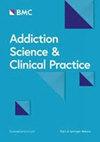合并药物使用障碍患者的入院情况:对 NavSTAR 试验预测因素的二次分析
IF 3.7
2区 医学
Q1 SUBSTANCE ABUSE
引用次数: 0
摘要
患有药物使用障碍(SUDs)的人经常使用急诊住院服务。避免再次住院的导航服务(NavSTAR)试验发现,与 "常规治疗"(TAU)相比,为合并 SUD 的住院患者提供的患者导航干预减少了患者的后续住院次数。这项二次分析扩展了 NavSTAR 试验之前的研究结果,研究了选定的患者特征是否能独立预测医院服务利用率并调节 NavSTAR 干预的效果。参与者为 400 名合并 SUDs 的内科/外科住院患者。我们分别使用多变量逻辑回归和负二项回归分析了 30 天和 90 天的住院再入院率(一次或多次再入院)以及 12 个月的住院累积发生率。与主要研究结果一致,在控制了患者因素后,NavSTAR 参与者比 TAU 参与者在 30 天(P = 0.001)和 90 天(P = 0.03)内再入院的可能性更小,12 个月内再入院的总次数也更少(P = 0.008)。上一年的住院情况(P < 0.001)与 12 个月内的累计再入院次数有关,而医疗补助保险(P = 0.03)、感染(P = 0.001)和受伤、中毒或手术并发症(P = 0.004)与较少的再入院次数有关。所选的协变量均不影响NavSTAR干预的效果。之前的研究结果表明,患者导航可以减少合并 SUDs 患者的重复入院率。一些患者因素与再入院有独立关联。未来的研究应调查合并 SUDs 患者再次入院的风险因素,以优化干预措施。NIH ClinicalTrials.gov NCT02599818,2015年11月9日注册 https://classic.clinicaltrials.gov/ct2/show/NCT02599818 。本文章由计算机程序翻译,如有差异,请以英文原文为准。
Hospital admissions among patients with Comorbid Substance Use disorders: a secondary analysis of predictors from the NavSTAR Trial
Individuals with substance use disorders (SUDs) frequently use acute hospital services. The Navigation Services to Avoid Rehospitalization (NavSTAR) trial found that a patient navigation intervention for hospitalized patients with comorbid SUDs reduced subsequent inpatient admissions compared to treatment-as-usual (TAU). This secondary analysis extends previous findings from the NavSTAR trial by examining whether selected patient characteristics independently predicted hospital service utilization and moderated the effect of the NavSTAR intervention. Participants were 400 medical/surgical hospital patients with comorbid SUDs. We analyzed 30- and 90-day inpatient readmissions (one or more readmissions) and cumulative incidence of inpatient admissions through 12 months using multivariable logistic and negative binomial regression, respectively. Consistent with primary findings and controlling for patient factors, NavSTAR participants were less likely than TAU participants to be readmitted within 30 (P = 0.001) and 90 (P = 0.03) days and had fewer total readmissions over 12 months (P = 0.008). Hospitalization in the previous year (P < 0.001) was associated with cumulative readmissions over 12 months, whereas Medicaid insurance (P = 0.03) and index diagnoses of infection (P = 0.001) and injuries, poisonings, or procedural complications (P = 0.004) were associated with fewer readmissions. None of the selected covariates moderated the effect of the NavSTAR intervention. Previous findings showed that patient navigation could reduce repeat hospital admissions among patients with comorbid SUDs. Several patient factors were independently associated with readmission. Future research should investigate risk factors for hospital readmission among patients with comorbid SUDs to optimize interventions. NIH ClinicalTrials.gov NCT02599818, Registered November 9, 2015 https://classic.clinicaltrials.gov/ct2/show/NCT02599818 .
求助全文
通过发布文献求助,成功后即可免费获取论文全文。
去求助
来源期刊

Addiction Science & Clinical Practice
Psychology-Clinical Psychology
CiteScore
3.90
自引率
10.80%
发文量
64
审稿时长
28 weeks
期刊介绍:
Addiction Science & Clinical Practice provides a forum for clinically relevant research and perspectives that contribute to improving the quality of care for people with unhealthy alcohol, tobacco, or other drug use and addictive behaviours across a spectrum of clinical settings.
Addiction Science & Clinical Practice accepts articles of clinical relevance related to the prevention and treatment of unhealthy alcohol, tobacco, and other drug use across the spectrum of clinical settings. Topics of interest address issues related to the following: the spectrum of unhealthy use of alcohol, tobacco, and other drugs among the range of affected persons (e.g., not limited by age, race/ethnicity, gender, or sexual orientation); the array of clinical prevention and treatment practices (from health messages, to identification and early intervention, to more extensive interventions including counseling and pharmacotherapy and other management strategies); and identification and management of medical, psychiatric, social, and other health consequences of substance use.
Addiction Science & Clinical Practice is particularly interested in articles that address how to improve the quality of care for people with unhealthy substance use and related conditions as described in the (US) Institute of Medicine report, Improving the Quality of Healthcare for Mental Health and Substance Use Conditions (Washington, DC: National Academies Press, 2006). Such articles address the quality of care and of health services. Although the journal also welcomes submissions that address these conditions in addiction speciality-treatment settings, the journal is particularly interested in including articles that address unhealthy use outside these settings, including experience with novel models of care and outcomes, and outcomes of research-practice collaborations.
Although Addiction Science & Clinical Practice is generally not an outlet for basic science research, we will accept basic science research manuscripts that have clearly described potential clinical relevance and are accessible to audiences outside a narrow laboratory research field.
 求助内容:
求助内容: 应助结果提醒方式:
应助结果提醒方式:


